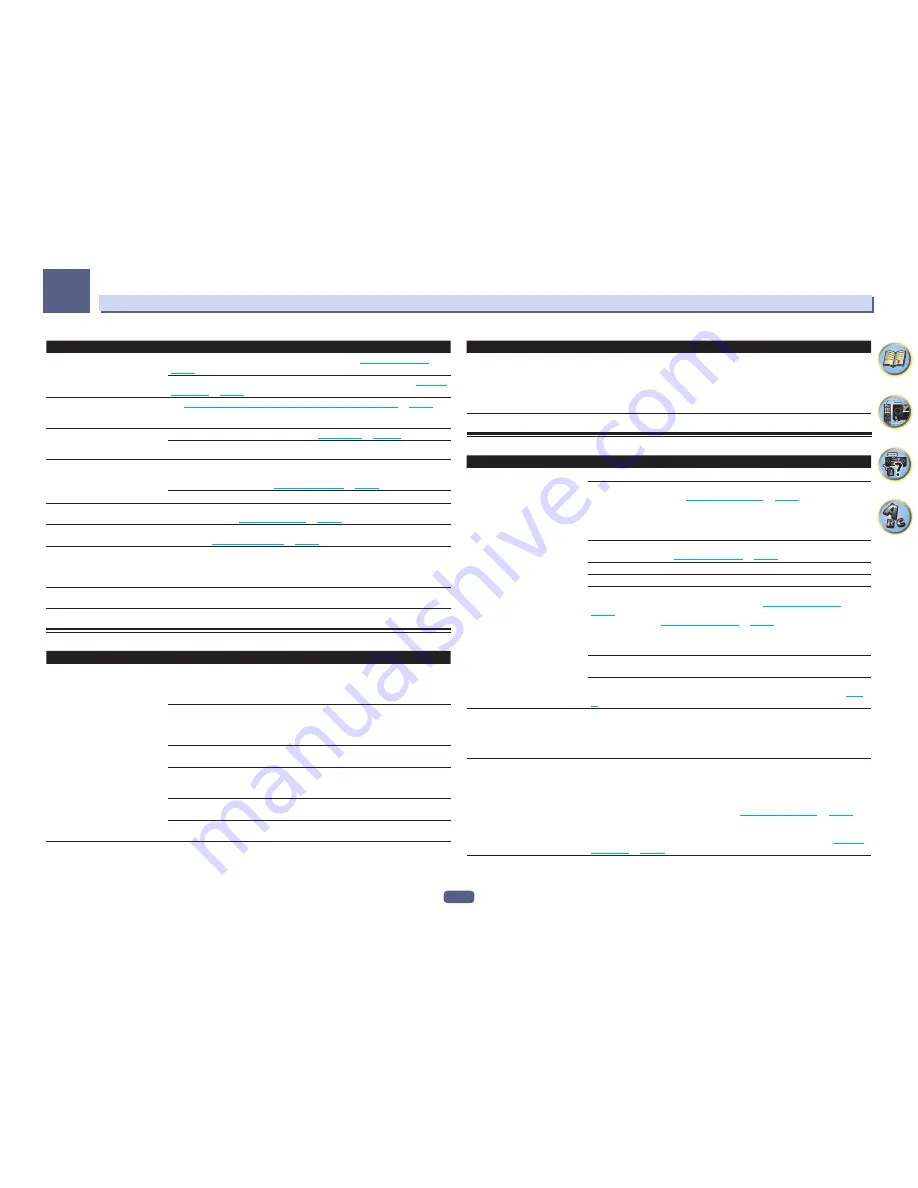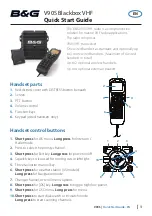
118
FAQ
13
Symptom
Remedy
Can’t select some Input functions
by the
INPUT SELECTOR
on the
front panel or the
ALL
button on the
remote control.
Check the
Input Skip
settings in the
Input Setup
menu (see
The Input Setup menu
on
page 52
).
Check the
HDMI Input
assignment in the
Input Setup
menu then try
OFF
(see
The Input
Setup menu
on
page 52
).
There seems to be a time lag
between the speakers and the output
of the subwoofer.
See
Automatically conducting optimum sound tuning (Full Auto MCACC)
on
page 51
to set up your system again using MCACC (this will automatically compensate for a delay
in the subwoofer output).
The maximum volume available
(shown in the front panel display) is
lower than the
+12dB
maximum.
Check that the
Volume Limit
is set to
OFF
(see
Volume Setup
on
page 111
).
The channel level setting may be over
0.0dB
.
Certain listening modes or
HOME MENU
items cannot be
selected.
When
Operation Mode
is set to
Basic
, the Pioneer-recommended settings are made and
not all of the functions can be used. To use all of the functions without restrictions, set
Operation Mode
to
Expert
(see
Operation Mode Setup
on
page 53
).
Some functions cannot be selected, depending on the input signal and listening mode.
The volume level drops automati-
cally.
The temperature within the unit has exceeded the allowable value. Try moving the unit for
better ventilation (see
Installing the receiver
on
page 11
).
Volume seems different when input
is switched.
Set the
Channel Level
setting to
ALL
, then adjust the volume of the respective input
sources (see
Input Volume Absorber
on
page 87
).
When
HDZONE
is
ON
, multi-channel
audio sources are not output in the
main zone.
When
HDZONE
is selected in
Speaker System
and also the same HDMI input is selected
for both the main zone and HDZONE, 2-channel PCM audio sources are output from the
main zone as well. To output multi-channel audio sources, set
HDZONE
to
OFF
or change
the HDZONE input.
No HDZONE sound is output.
With HDZONE, multi-channel audio may not be output. In this case, set the audio output
setting of your playback device to 2-channel PCM.
ADAPTER PORT terminal
Symptom
Remedy
The
Bluetooth
wireless technology
device cannot be connected or oper-
ated. Sound from the
Bluetooth
wire-
less technology device is not emitted
or the sound is interrupted.
Check that no object that emits electromagnetic waves in the 2.4 GHz band (microwave
oven, wireless LAN device or
Bluetooth
wireless technology apparatus) is near the unit. If
such an object is near the unit, set the unit far from it. Or, stop using the object emitting
the electromagnetic waves.
Check that the
Bluetooth
wireless technology device is not too far from the unit and that
obstructions are not set between the
Bluetooth
wireless technology device and the unit.
Set the
Bluetooth
wireless technology device and the unit so that the distance between
them is less than about 10 m (33 ft.) and no obstructions exist between them.
Check that the
Bluetooth
ADAPTER and the
ADAPTER PORT
of the unit are correctly
connected.
The
Bluetooth
wireless technology device may not be set to the communication mode
supporting the
Bluetooth
wireless technology. Check the setting of the
Bluetooth
wireless
technology device.
Check that pairing is correct. The pairing setting was deleted from this unit or the
Blue-
tooth
wireless technology device. Reset the pairing.
Check that the profile is correct. Use a
Bluetooth
wireless technology device that sup-
ports A2DP profile and AVRCP profile.
Symptom
Remedy
ADT OVERLOAD
is displayed on the
display.
There is a problem in the power supply for the
Bluetooth
adapter. After turning OFF the
power of the receiver, disconnect the
Bluetooth
adapter and insert the
Bluetooth
adapter
again, then turn ON the power of the receiver.
If
ADT OVERLOAD
is displayed even though the above operation is repeated several
times, there is a problem with the receiver or the
Bluetooth
adapter. Disconnect the
power cable and request repair.
Video
Symptom
Remedy
No image is output when an input is
selected.
Check the video connections of the source component.
For HDMI, or when
V.CONV
is set to
OFF
and a TV and another component are con-
nected with different cords (in
Setting the Video options
on
page 83
), you must connect
your TV to this receiver using the same type of video cable as you used to connect your
video component. For the component video input, however, signals are only output from
the
HDMI OUT 1
or
HDMI OUT 2
terminal, so when using the component video input,
set
V.CONV
to
OFF
.
Make sure the input assignment is correct for components connected using component
video or HDMI cables (see
The Input Setup menu
on
page 52
).
Check the video output settings of the source component.
Check that the video input you selected on your TV is correct.
Some components (such as video game units) have resolutions that may not be con-
verted. If adjusting this receiver’s Resolution setting (in
Setting the Video options
on
page 83
) and/or the resolution settings on your component or display doesn’t work, try
switching
V.CONV
(in
Setting the Video options
on
page 83
) to
OFF
.
When the device is connected using an
HDMI OUT
terminal, press the remote control’s
OUT P.
button to check the
HDMI OUT
output setting. For
OUT 3/4
, also check the
MAIN/HDZONE
setting at
ZONE Setup
.
When the
HDMI
OUT 1/2
setting of the output parameter function is set to
OFF
, set it to
ON
.
If HDZONE is set to on, video images connected using a video cable or component cable
are not output from the HDMI terminal. To output video images, turn HDZONE off (
page
87
).
Noisy, intermittent, or distorted
picture.
Sometimes a video deck may output a noisy video signal (during scanning, for example),
or the video quality may just be poor (with some video game units, for example). The
picture quality may also depend on the settings, etc. of your display device. Switch off
the video converter and reconnect the source and display device using the same type of
connection (component or composite), then start playback again.
Video signals are not output from the
component terminal.
When a monitor only compatible with resolutions of 480i is connected to the component
terminal and another monitor is connected to the HDMI terminal, the video signals may
not be output to the monitor connected to the component terminal. If this happens, do
the following:
— Turn off the power of the monitor connected to the HDMI terminal.
— Change the
VIDEO P.
menu
RES
setting (see
Setting the Video options
on
page 83
).
— Video signals from the HDMI terminal cannot be output to the component terminals.
Input the video signals from the player or other source to the composite or component
terminals. When using the component terminal, assign it at
Input Setup
(see
The Input
Setup menu
on
page 52
).
Summary of Contents for Elite SC-87
Page 1: ...Operating Instructions AV Receiver SC 87 SC 89 ...
Page 13: ...13 Remote control 14 Display 16 Front panel 17 Controls and displays ...
Page 142: ...Dolby Atmos Home Theater Installation Guidelines September 2014 ...
Page 157: ... 16 Figure 8 Standard 5 1 2 setup with overhead speakers ...
Page 158: ... 17 Figure 9 Standard 5 1 2 setup with Dolby Atmos enabled speakers ...
Page 159: ... 18 Figure 10 Standard 5 1 4 setup with overhead speakers ...
Page 160: ... 19 Figure 11 Standard 5 1 4 setup with Dolby Atmos enabled speakers ...
Page 161: ... 20 Figure 12 Standard 7 1 2 setup with overhead speakers ...
Page 162: ... 21 Figure 13 Standard 7 1 2 setup with Dolby Atmos enabled speakers ...
Page 163: ... 22 Figure 14 Standard 7 1 4 setup with overhead speakers ...
Page 164: ... 23 Figure 15 Standard 7 1 4 setup with Dolby Atmos enabled speakers ...
Page 165: ... 24 Figure 16 Standard 9 1 2 setup with overhead speakers ...
Page 166: ... 25 Figure 17 Standard 9 1 2 setup with Dolby Atmos enabled speakers ...
Page 188: ......
















































